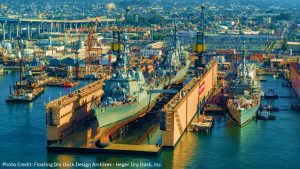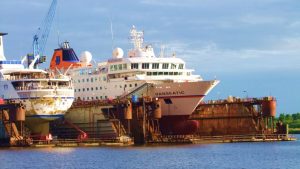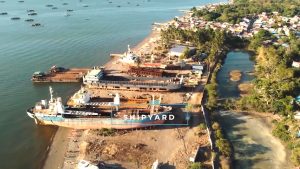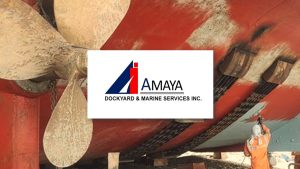Floating docks in the Philippines have become increasingly popular in recent years, revolutionizing the way we enjoy waterfront activities. Whether it’s for leisurely boat rides, fishing ventures, or simply soaking up the sun, these versatile platforms offer a stable and convenient solution. However, one question that often arises is just how much weight floating docks can lift. With their buoyant nature and seemingly simple design, it’s easy to underestimate their capabilities. In this article, we will dive into the fascinating world of floating docks and explore the factors that influence their weight-bearing capacity. Prepare to be amazed at just how much these ingenious structures can handle!
Click here to view our shipyard facility in Tanza, Cavite, Philippines.
The Concept of Floating Docks and Their Uses
Floating docks are a game-changer when it comes to coastal engineering and waterfront development in the Philippines. As the name suggests, these docks float on the surface of the water rather than being fixed to the shore or seabed. This innovation offers numerous advantages over traditional docks, making them increasingly popular in both residential and commercial settings.
One of the key benefits of floating docks is their adaptability and versatility. They can be easily customized to fit various configurations and accommodate different types of vessels, whether it’s a small kayak or a large yacht. The modular design allows for easy expansion or reconfiguration as needs evolve. Additionally, floating docks are suitable for locations with fluctuating water levels or uneven terrain, as they adjust accordingly while maintaining stability.
Furthermore, floating docks in the Philippines have environmental advantages that extend beyond their flexible design. Unlike traditional anchored docks that disrupt aquatic ecosystems by blocking sunlight and impeding natural water flow, floating docks offer minimal disruption to the environment. With features such as air-filled floatation devices that keep them buoyant, these structures preserve marine habitats and allow for underwater vegetation growth.
Overall, floating docks have revolutionized coastal infrastructure by providing practical solutions for waterfront development while minimizing ecological impact. Their adaptability, versatility, and environmentally friendly nature make them an ideal choice for anyone looking to maximize functionality while ensuring sustainability along our precious shorelines.

Understanding Buoyancy: Principles Behind Floating Docks in the Philippines
Understanding buoyancy is crucial to comprehend the principles behind floating docks in the Philippines. These innovative structures utilize buoyant materials and clever engineering to support heavy loads on water bodies. Unlike fixed docks, which are anchored to the seabed, floating docks rely on their buoyancy to stay afloat while accommodating various activities such as boat mooring, swimming, or even serving as event venues.
One of the key factors contributing to the buoyancy of these floating docks is their design. They are typically constructed using sturdy materials like high-density polyethylene (HDPE) or concrete that have excellent buoyant properties. Additionally, strategically placed air chambers and floatation devices further enhance their stability and lifting capacity. This allows them to support large amounts of weight without sinking or capsizing safely.
Another interesting aspect of floating docks is how they distribute weight evenly across their surface area. This principle prevents concentrated stress points and ensures stability even when subjected to dynamic loads such as waves or strong currents. By dispersing forces uniformly through its structure, a properly designed floating dock can effectively lift significant weights without compromising safety.
With its unique design and utilization of principles in fluid mechanics, understanding buoyancy is vital for comprehending how floating docks can successfully operate in the Philippines’ diverse aquatic environments. The advanced engineering techniques employed by these structures allow for safe and efficient access to bodies of water while maintaining stability under demanding conditions.

Maximum Weight Capacity of Different Types of Floating Docks
Floating docks are an essential element of coastal infrastructure in the Philippines, providing a means for people to access boats and watercraft while ensuring safety and convenience. However, one crucial aspect that often goes unconsidered is their weight capacity. The maximum weight capacity of floating docks can vary depending on various factors, such as the type of dock material, design, and buoyancy.
Wooden docks, commonly found in many coastal areas around the Philippines archipelago, usually have a weight capacity ranging from 20 to 40 pounds per square foot. These docks are built with wooden planks supported by foam-filled drums or barrels attached underneath. They provide stability for pedestrians but can only handle light loads such as personal watercraft or small boats.
On the other hand, concrete floating docks have significantly higher weight capacities compared to their wooden counterparts. Concrete pontoons filled with foam offer better buoyancy and durability under heavy loads. These types of floating docks typically have a weight capacity ranging between 50 to 70 pounds per square foot. This increased capacity allows for larger boats, yachts, or even small commercial vessels to be safely moored without compromising the integrity of the structure.
Understanding the maximum weight capacities of different types of floating docks is crucial when planning marine infrastructure projects or considering purchasing a dock for personal use in the Philippines.
Factors Affecting the Weight Capacity of Floating Docks in the Philippines
One of the key factors that affect the weight capacity of floating docks in the Philippines is the materials used for construction. The type and quality of materials can greatly influence how much weight a dock can lift. In areas with corrosive seawater, such as near industrial ports or boat marinas, it may be necessary to use high-grade materials that are resistant to rust and deterioration to ensure optimal weight capacity.
Another factor that plays a significant role in determining weight capacity is the design and engineering of the floating docks. Docks designed with larger pontoon chambers have a greater buoyancy force, allowing them to support heavier loads. Additionally, certain designs incorporate factors like wave energy reduction systems or anti-slip features, which can impact their overall load-bearing capabilities. Consulting an experienced marine engineer during the planning and construction process is essential for ensuring optimal weight capacities based on specific site conditions.
Balancing material selection with well-designed engineering specifications is crucial for maximizing the weight capacity of floating docks in the Philippines. By understanding these factors and consulting experts, people can ensure they have reliable and durable floating docks that meet their needs while also adhering to safety standards. Whether it’s for commercial purposes or personal use, taking into consideration these factors will help guarantee long-term success and satisfaction when utilizing floating docks in coastal areas throughout the country.
Different Types of Floating Dock Materials and Their Weight Capacity in the Philippines
When it comes to floating dock materials, there are several options available in the Philippines. One popular choice is concrete, which is known for its durability and stability. Concrete docks can withstand heavy loads and have a high weight capacity, making them suitable for commercial purposes such as marinas or boat docks. However, they can be quite expensive to construct and require regular maintenance to prevent corrosion.
Another commonly used material for floating docks is plastic or polyethylene. These docks are lightweight, easy to install, and require minimal maintenance. While they may not have the same weight capacity as concrete docks, they are still capable of supporting smaller boats and watercraft in residential areas or private establishments. Additionally, plastic docks are more affordable and can be customized according to individual requirements.
Alternatively, if budget is a constraint, but strength is still a concern, steel-frame floating docks offer an excellent option. These docks provide sturdy support while being cost-effective compared to concrete options. Steel-frame floating docks have a moderate weight capacity that can handle recreational boat traffic and other light applications without compromising structural integrity.
Choosing the right floating dock material depends on various factors, such as budget constraints and intended usage. Concrete offers superior weight capacity but comes with higher costs and maintenance requirements. Plastic or polyethylene provides a lightweight yet durable option suitable for smaller watercraft in residential or private settings at a more affordable price point. Lastly, steel-frame floating docks offer moderate strength at an economical value for recreational purposes.

Examples of Typical Weight Capacities for Different Sizes of Floating Docks
When it comes to floating docks in the Philippines, there is no one-size-fits-all weight capacity. The maximum load that a floating dock can support depends on various factors, including its size and design. In general, smaller floating docks with dimensions of around 10 feet by 10 feet have weight capacities ranging from 500 to 1,000 pounds. These docks are suitable for personal use or for small boats such as kayaks or jet skis.
Moving up in size, medium-sized floating docks with dimensions of around 20 feet by 20 feet can handle weight capacities of approximately 2,000 to 5,000 pounds. This makes them suitable for recreational purposes such as fishing or mooring larger vessels like pontoon boats. For commercial applications or larger recreational areas, large floating docks measuring around 30 feet by 30 feet or more can have weight capacities exceeding 10,000 pounds.
It’s important to note that while these weight capacity ranges provide a general idea of what different sizes of floating docks can bear, specific models and designs may have slightly different capabilities. It’s always wise to consult the manufacturer’s guidelines and recommendations to ensure the safety and longevity of any floating dock installation in the Philippines.

Considerations for Choosing the Right Floating Dock in the Philippines
When considering the right floating dock in the Philippines, it’s important to take into account factors such as water conditions, location, and purpose. The first thing to consider is the type of water condition you’ll be using the dock in. If you’ll be on a calm lake or a sheltered bay, a lighter-duty dock may suffice. However, if you plan to use it in rougher waters or near open ocean areas where there are strong currents or waves, you’ll want to invest in a heavy-duty dock that can withstand these conditions.
Location is another crucial aspect to consider when choosing a floating dock. Different locations will have different regulatory requirements and restrictions that need to be considered. For instance, some coastal areas may have strict regulations regarding docks due to environmental concerns or preservation efforts. It’s essential to research and understand any restrictions before investing in your dock.
Lastly, having a clear understanding of your intended use for the floating dock is key. Are you planning on using it for residential purposes such as boat docking or lounging? Or do you have commercial needs like running tours or fishing charters? Knowing how much weight capacity and what features are necessary for your specific use will help narrow down your options and ensure that you choose the right floating dock.

Looking for the Best Shipyard in the Philippines?
Amaya Dockyard & Marine Services Inc. (ADMSI) is a leading shipyard in the Philippines, providing cost-effective solutions for ship repair and shipbuilding needs. With state-of-the-art facilities and a team of highly skilled Filipino engineers, ADMSI offers comprehensive services to both domestic and international clients.
- Email us: info@amayadockyard.com
- Call our 24-hour hotline: +63 917 633 0479
- Viber: +63 917 633 0479
- WhatsApp: +63 917 633 0479
- Facebook Messenger: Click here
- Click here to inquire
One of the key advantages of choosing ADMSI as your shipyard in the Philippines is our ability to provide cost-effective solutions without compromising on quality. The team at ADMSI understands the importance of keeping costs under control while ensuring that all repairs or construction meet industry standards.
Furthermore, ADMSI’s strategic location in Tanza Cavite makes it an ideal choice for any maritime project. Cavite boasts excellent infrastructure and logistics support, making it easy for ships to access the facility without any hassle. This proximity also allows for quick turnaround times, minimizing downtime for vessel owners.
Whether you are looking for ship repair or shipbuilding services in the Philippines, Amaya Dockyard & Marine Services Inc. (ADMSI) is your go-to solution provider. With their expertise, commitment to cost-effectiveness, and convenient location, they are well-positioned to meet all your maritime needs efficiently and excellently.
Takeaway: How Much Weight Can Floating Docks Lift in the Philippines?
In conclusion, floating docks in the Philippines have proven to be incredibly versatile and efficient when it comes to lifting heavy loads. With a range of sizes and weight capacities available, these docks can handle anywhere from a few hundred kilograms to several tons. This makes them an ideal choice for various industries such as construction, tourism, and aquaculture.
However, it is important to note that the weight capacity of a floating dock is not solely determined by its size or design. Other factors such as water conditions, maintenance, and anchoring systems also play significant roles in determining its lifting capabilities. Therefore, it is crucial for individuals or businesses looking to utilize floating docks for heavy lifting purposes to consider these factors and consult experts carefully if needed.
Overall, the use of floating docks has revolutionized marine operations in the Philippines by providing a reliable and efficient solution for lifting heavy loads. As technology advances and new materials are introduced into their construction, we can expect even greater weight capacities in the future. Whether it’s transporting construction materials or supporting large-scale events on water bodies, floating docks continue to prove their worth as essential equipment in various industries across the country.



